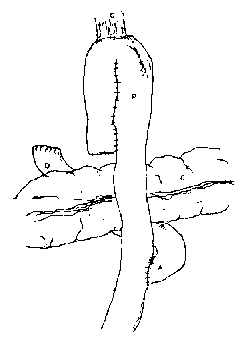Total gastrectomy is rarely performed in children.
Follow-up of adult gastrectomy patients has shown that profound
malnutrition occurs even without recurrence of malig-nancy. Nearly 70%
of these patients have fat absorption defect and 60% impairment in
protein absorption.
Reconstruction of a reservoir to simulate stomach
reservoir function becomes all the more necessary in the pediatric age
group for nutritional and overall development of the child. The
Hunt-Lawrence pouch, the most popular of these reservoirs, has been
reported so far in the pediatric age group only in isolated cases of
corrosive gastric cicatrisa-tion and neonatal gastric perforation as
well as in cases of congenital microgastria, a rare entity in
itself(1-3). An extensive search of both Indian and western literature
failed to show any previous report of creation of a jejunal pouch
reservoir following total gastrectomy for gastric volvulus.
We report a case of a child who had undergone total
gastrectomy for gastric vol-vulus with subsequent severe weight loss and
malnutrition. A Hunt-Lawrence pouch was constructed and the child at 4
years follow-up has regained near normal weight for his age and is
attending to school and other activities.
Case Report
A 12-year-old boy was referred with suspected
perforation of esophagus during a dilatation procedure for dysphagia.
Six months earlier, the child had been operated in a peripheral hospital
for perforation perito-nitis. At this laparotomy, he was found to have
gastric volvulus with near total gastric necrosis for which total
gastrectomy, splenectomy and Roux-en-Y esophago-jejunal anastomosis had
been performed. Two months after surgery, he developed progressive
dysphagia and a barium study showed narrowing at the anastomotic site.
He was then referred to the gastroenterology service and had undergone
esophageal dilatation twice prior to this episode. Over this period of
six months, before he was admitted with us, the child had lost 16 kg and
was emaciated and malnourished.
After resuscitation, the patient was taken up for
laparotomy and was found to have jejunal perforation 3 cm distal to the
strictured site of esophago-jejunal anastomosis. The perforation was
closed and a feeding jejuno-stomy created. Nutritional rehabilitation in
the form of partial parenteral nutrition and jejunostomy feeds was
accomplished. Over the next two months, the child regained some lost
weight. He was then planned for a gastric reservoir. The strictured
esophago-jejunal anastomosis was excised and a Hunt Lawrence pouch (Fig.1)
was constructed, retaining the feeding jejunostomy. The technique of
this operation was as follows: The jejunum was divided 10 cm from the
duodeno-jejunal flexure between the 3rd and 4th vascular arcades. The
distal end was closed and a long entero-enteric anastomosis was
performed between the closed afferent limb and the adjacent efferent
limb for about 15 cm. The esophagus was anastomosed to the jejunal pouch
via a longitudinal jejunotomy equal to the width of the esophagus. The
proximal end of the afferent limb was now anastomosed end to side to the
efferent limb some 40 cm distal to the esophago-jejunostomy. A Stamm
type feeding jejunostomy was made 10 cm distal to the jejuno-jejunostomy.
On the 12th postoperative day, a contrast study was performed which
showed no evidence of leak. Oral feeds were initiated, slowly
progressing to semisolids and solids. There was no dysphagia or
regurgitation. The child was put on regular vitamin supplements,
especially vitamin B12 injections once a month.

Fig. 1. Line diagram depicting Hunt-Lawrence pouch.
O: esophagus; P: pouch; D: duo-denum; C: colon; A: distal jejuno-jejunal
anastomosis.
A barium meal study showed pouch-emptying time of one
hour. Radioisotope labeled pouch-emptying studies showed a liquid meal
emptying time of 35 minutes and a solid meal emptying time of 75
minutes. A fecal fat excretion test showed a fat concentration of 3.5 g
(normal less than 7 g per day). At 4-year follow up, the child is eating
normal diet though in smaller quantity, has gained further 10 kg with
corresponding increase in height, is attending school and is
asymptomatic.
Discussion
Malabsorption of protein and fat and continued weight
loss commonly occurs after total gastrectomy(1). The greatest limiting
factor is the lack of adequate oral intake. Most patients learn to eat
small frequent meals through out the day avoiding hyperosmolar foods.
The lack of gastric acid also results in overgrowth of anerobic jejunal
bacteria, which further contributes to the mal-absorption(4,5).
Various gastric substitutes have been described,
mostly using the Roux-en-Y principle. The most popular of these
reser-voirs is the Hunt-Lawrence pouch, which was first described by
Hunt(6) and subsequently modified by Lawrence(7). The large food
reservoir of this pouch is accompanied by a diminished incidence of
post-prandial full-ness and rapid intestinal transit, thus reducing the
incidence of dumping syndrome(4). All these qualities enable the patient
to eat adequately and comfortably and resume their preoperative
activities. Alkaline reflux gastritis can however cause uncomfortable
symptoms, though our patient is currently asymptomatic.
All patients with total gastrectomy of 2 years
duration, regardless of the type of replacement procedure, need
supplementary vitamin B12 administration on a continuing monthly basis
to prevent eventual megalo-blastic anemia(8). Long term results of
reconstructive procedures can be assessed by endoscopy with biopsies of
esophagus and jejunum; barium meal cinefluoro-graphic studies for
assessment of jejunal pouch size, peristalsis, presence of stasis, pouch
dilatation and reflux; jejunal pouch emptying studies by isotope
labeling of food as well as evaluation of absorptive function by d-xylose
test, fecal fat loss etc.(9).
Contributors: PM and IS drafted the manuscript,
performed literature search and contributed to patient management. SKC
prepared final draft of manuscript and contributed to patient
management. KLNR operated the patient and finalized the manuscript. He
will act as guarantor for manuscript.
Funding: None.
Competing interests: None stated.
